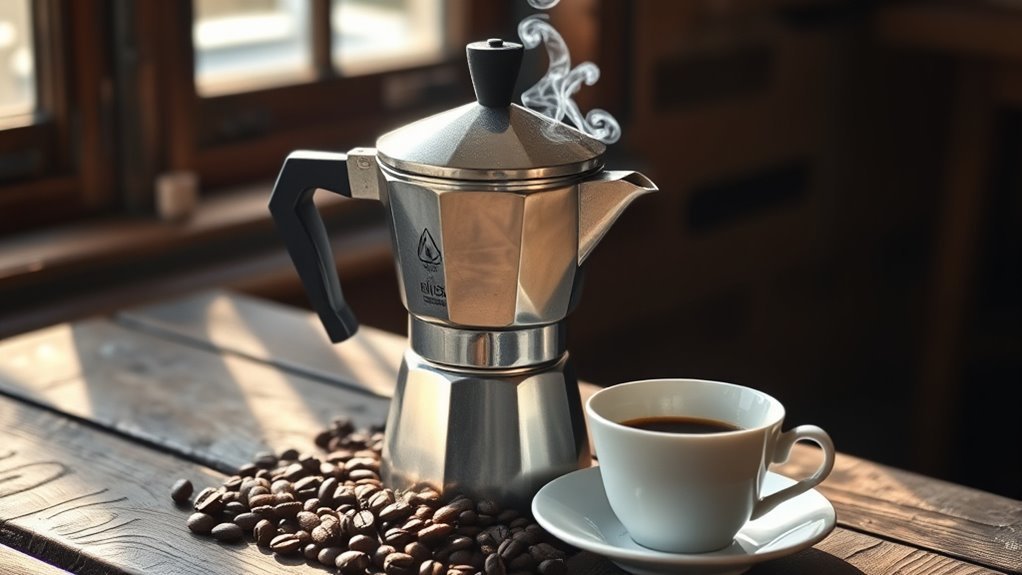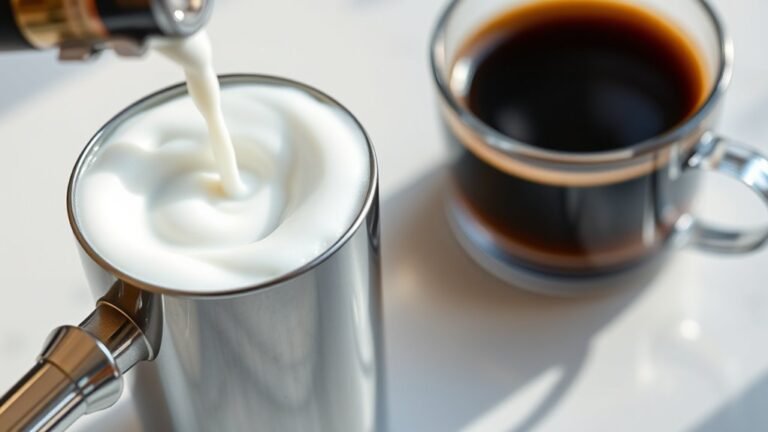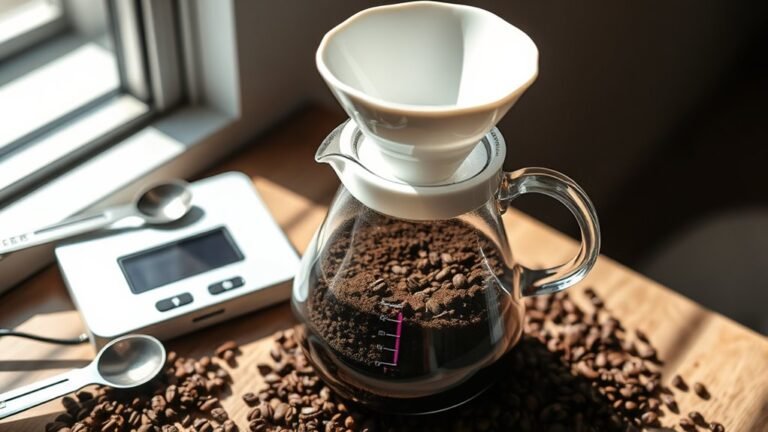The Best Coffee for Moka Pot
For the best moka pot coffee, use a grind finer than drip but coarser than espresso to guarantee balanced extraction without clogging. Choose dark or medium roast beans to match your flavor preference—dark for bold, smoky intensity or medium for balanced sweetness and acidity. Opt for fresh, well-stored beans in airtight containers to lock in flavor. Single-origin beans highlight unique notes, while blends offer smooth complexity. Keep exploring these factors to perfect your moka pot brew.
Understanding the Grind Size for Moka Pot

Grind size plays a crucial role in brewing with a moka pot, as it directly affects extraction time and flavor balance. You’ll want a grind consistency finer than drip but coarser than espresso to guarantee ideal pressure and flow. If the grind’s too fine, you risk over-extraction, bitter notes, and clogged filters. Too coarse, and under-extraction leads to weak, sour flavors. Maintaining uniform grind particles helps avoid channeling, guaranteeing even water contact and steady extraction. Also, keep in mind the brew temperature: higher temperatures accelerate extraction, so a balanced grind size must complement your stove’s heat to prevent bitterness or sourness. Mastering grind size and consistency gives you control over your moka pot’s full-bodied, rich coffee experience—perfect for those who crave freedom in their brew.
Ideal Coffee Roast Levels for Moka Brewing
Once you’ve nailed the right grind size, the next factor shaping your moka pot brew is the roast level of your coffee. For moka brewing, dark roast beans are a popular choice because their bold, smoky flavors stand up well to the high pressure and heat, delivering a rich, intense cup. However, if you prefer a bit more complexity and brightness, a medium roast can offer a balanced profile with subtle acidity and nuanced sweetness. The medium roast doesn’t overshadow the moka pot’s characteristic robustness but adds layers of flavor without bitterness. Ultimately, your choice between dark roast and medium roast depends on whether you want a deep, powerful espresso-like experience or a freer, more vibrant cup. Both roasts reveal different facets of moka brewing’s potential.
Single-Origin vs. Blends: What Works Best
How do you decide between single-origin coffees and blends for your moka pot? Single origin advantages lie in their distinctive, unadulterated flavor profiles—think bright acidity from Ethiopian beans or rich chocolate notes from Colombian varieties. These coffees let you explore specific terroirs, perfect if you crave freedom in flavor exploration. Blends, meanwhile, marry blend characteristics like balance and complexity, combining beans to create a consistent, harmonious cup. They often temper extremes, providing smoothness and full body, which works well with moka pot’s concentrated brew. Your choice depends on whether you want to savor unique, traceable flavors or prefer a reliable, nuanced experience. Both can shine in your moka pot, but understanding their traits helps you select the coffee that truly suits your taste journey.
Tips for Storing Coffee to Maintain Freshness

Because coffee begins to lose its freshness soon after roasting, proper storage is vital to preserve the flavors you want in your moka pot brew. To maintain that vibrant taste, keep your beans in airtight containers, which prevent exposure to oxygen, moisture, and light—three main culprits of flavor degradation. Vacuum sealing is even better, as it removes air entirely, locking in aroma and freshness for longer periods. Store your coffee in a cool, dark place away from heat sources or sunlight to avoid accelerated aging. Avoid frequent opening of containers; portion out what you need to minimize exposure. By controlling these factors, you guarantee your moka pot coffee stays rich and lively, giving you the freedom to enjoy every cup at its peak quality.
Recommended Coffee Brands for Moka Pots
Choosing the right coffee brand can greatly enhance your moka pot experience, as not all beans are created equal when it comes to this brewing method. Look for brands like Illy and Lavazza, known for their balanced coffee flavor profiles that complement moka pot brewing techniques perfectly. If you prefer a bolder taste, coffee from Kimbo offers rich, intense notes that hold up well under pressure. For those who cherish freedom in flavor, Stumptown’s medium roast provides bright acidity and complexity, ideal for nuanced moka pot extraction. Always choose freshly roasted beans with a medium to fine grind to maximize extraction. By selecting brands that understand moka pot nuances, you guarantee a vibrant, robust cup that truly celebrates your brewing ritual and personal taste preferences.
Frequently Asked Questions
Can I Use Pre-Ground Coffee Instead of Grinding Fresh for a Moka Pot?
You can use pre ground coffee for your moka pot, but keep in mind that coffee freshness plays a big role in flavor. Pre ground coffee often loses aroma and oils faster than freshly ground beans, which might result in a less vibrant cup. If you want the freedom to enjoy convenience, choose high-quality pre ground coffee stored properly in an airtight container to preserve freshness as much as possible.
How Does Water Temperature Affect Moka Pot Brewing?
It’s no coincidence that water temperature plays a vital role in moka pot brewing—it directly impacts extraction and your brew consistency. If your water’s too hot, you risk over-extracting bitter compounds; too cool, and you’ll under-extract, losing flavor depth. Plus, water quality influences how heat transfers and interacts with coffee grounds. By controlling temperature and using good water, you open up freedom to craft a balanced, rich cup every time.
Is It Necessary to Tamp Coffee Grounds in a Moka Pot?
You don’t need to use a tamping technique with your moka pot like you would with an espresso machine. Pressing the grounds too firmly can restrict water flow and disrupt the ideal brewing pressure, causing bitter or weak coffee. Instead, fill the filter basket loosely, leveling the grounds gently. This allows the water to flow evenly under the moka pot’s lower pressure, giving you a balanced extraction without sacrificing your brewing freedom.
Can Flavored Coffee Beans Be Used in a Moka Pot?
You can definitely use flavored beans in your moka pot, but keep in mind that these beans often have added oils or coatings that might affect your brewing techniques. The moka pot’s pressure and heat can intensify flavors, sometimes making them taste stronger or slightly different than expected. If you enjoy experimenting, flavored beans offer a unique twist, but you may want to adjust grind size or brewing time to balance extraction and avoid bitterness.
How Often Should I Clean My Moka Pot for Best Flavor?
You should clean your moka pot after every use to maintain the best flavor and avoid buildup. Regular cleaning frequency guarantees oils and residue don’t alter your coffee’s taste. For maintenance tips, rinse all parts with warm water—skip soap to preserve the pot’s seasoning. Occasionally, do a deep clean by soaking components in a vinegar solution to remove mineral deposits. This routine keeps your moka pot performing freely and flavorfully.






